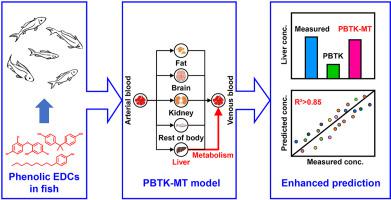Environmental Pollution ( IF 7.6 ) Pub Date : 2022-09-27 , DOI: 10.1016/j.envpol.2022.120290 Yue-Hong Liu 1 , Li Yao 2 , Zheng Huang 3 , Yuan-Yuan Zhang 3 , Chang-Er Chen 1 , Jian-Liang Zhao 1 , Guang-Guo Ying 1

|
Bisphenol A (BPA), 4-nonylphenol (4-NP), and triclosan (TCS) are phenolic endocrine disrupting chemicals (EDCs), which are widely detected in aquatic environments and further bioaccumulated and metabolized in fish. Physiologically based toxicokinetic (PBTK) models have been used to describe the absorption, distribution, metabolism, and excretion (ADME) of parent compounds in fish, whereas the metabolites are less explored. In this study, a PBTK incorporating metabolism (PBTK-MT) model for BPA, 4-NP, and TCS was established to enhance the performance of the traditional PBTK model. The PBTK-MT model comprised 16 compartments, showing great accuracy in predicting the internal concentrations of three compounds and their glucuronidated and sulfated conjugates in fish. The impact of typical hepatic metabolism on the PBTK-MT model was successfully resolved by optimizing the mechanism for deriving the partition coefficients between the blood and liver. The PBTK-MT model exhibited a potential data gap-filling capacity for unknown parameters through a backward extrapolation approach of parameters. Model sensitivity analysis suggested that only five parameters were sensitive in at least two PBTK-MT models, while most parameters were insensitive. The PBTK-MT model will contribute to a well understanding of the environmental behavior and risks of pollutants in aquatic biota.
中文翻译:

通过基于生理学的毒代动力学结合代谢 (PBTK-MT) 模型增强对鱼类体内酚类内分泌干扰物及其代谢物内部浓度的预测
双酚 A (BPA)、4-壬基酚 (4-NP) 和三氯生 (TCS) 是酚类内分泌干扰化学品 (EDC),它们在水生环境中广泛检测,并在鱼类中进一步生物积累和代谢。基于生理的毒代动力学 (PBTK) 模型已被用于描述母体化合物在鱼类中的吸收、分布、代谢和排泄 (ADME),而对代谢物的探索较少。在本研究中,建立了 BPA、4-NP 和 TCS 的 PBTK 结合代谢 (PBTK-MT) 模型,以增强传统 PBTK 模型的性能。PBTK-MT 模型包含 16 个隔室,在预测鱼类中三种化合物及其葡糖醛酸化和硫酸化结合物的内部浓度方面表现出极高的准确性。通过优化推导血液和肝脏之间分配系数的机制,成功解决了典型肝脏代谢对 PBTK-MT 模型的影响。PBTK-MT 模型通过参数的反向外推方法展示了未知参数的潜在数据空白填充能力。模型敏感性分析表明,在至少两个 PBTK-MT 模型中只有五个参数是敏感的,而大多数参数是不敏感的。PBTK-MT 模型将有助于更好地了解水生生物群中污染物的环境行为和风险。模型敏感性分析表明,在至少两个 PBTK-MT 模型中只有五个参数是敏感的,而大多数参数是不敏感的。PBTK-MT 模型将有助于更好地了解水生生物群中污染物的环境行为和风险。模型敏感性分析表明,在至少两个 PBTK-MT 模型中只有五个参数是敏感的,而大多数参数是不敏感的。PBTK-MT 模型将有助于更好地了解水生生物群中污染物的环境行为和风险。











































 京公网安备 11010802027423号
京公网安备 11010802027423号